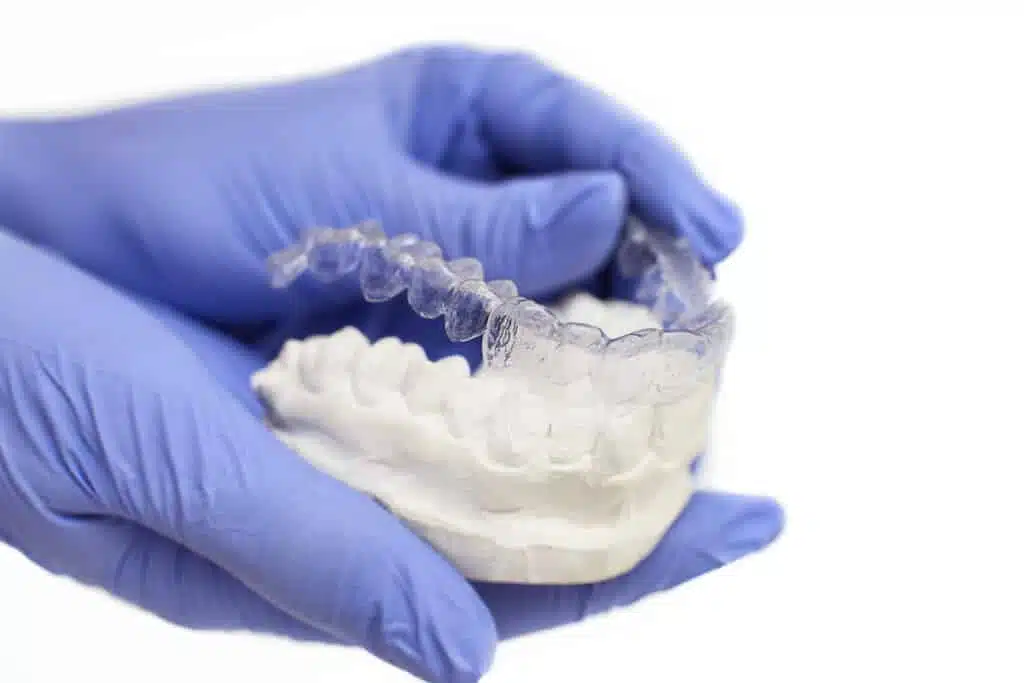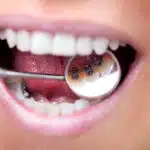There are different types of retainers to stabilize the teeth after tooth straightening. You can find all information about the topic here.
A retainer is an orthodontic appliance used after tooth correction to maintain the achieved tooth position.
It is a thin wire construction that is custom-fitted to the teeth and is either permanently attached to the back of the teeth or removable.
If the tooth correction was performed with aligners, invisible dental splints are used as retainers.
The retainer plays an important role in ensuring that the teeth do not move back to their previous position after correction.
| Get 150 € discount on your dental correction! |

Book a consultation appointment now at a nearby DrSmile partner practice and find out if teeth straightening with aligners is right for you.
The appointment is completely non-binding and does not involve any costs.
With the code “THATSMILE150” you will receive 150 € discount on the treatment.
Importance of a retainer for tooth correction
After a successful tooth correction with braces or aligners, it is important to maintain the newly achieved tooth position in the long term.
Without a retainer, there is a risk that the teeth will gradually return to their original position, as the tissue and bone structure need time to adapt to the new tooth position.
A retainer ensures that the teeth are stabilized and maintain their position.
What are the different types of retainers?
Depending on the previous type of tooth correction, there are different types of retainers. Among others, these include:
1. removable retainer
The removable retainer is another option to maintain the achieved tooth position.
It consists of a plastic plate that is individually made for the patient and covers either the entire row of teeth or only part of it.
The removable retainer is usually worn at night and during certain periods during the day.
The removable retainer provides flexibility and comfort. It can be easily removed to facilitate daily oral hygiene and allows the patient to perform certain activities, such as eating certain foods, without restrictions.
However, it is important to wear the removable retainer regularly according to the dentist’s instructions in order to maintain the desired tooth position.
If the teeth were corrected with aligners, invisible dental splints are used as retainers.
These are similar to the splints already worn during the course of treatment.

2. fixed retainer
A fixed retainer is also called a lingual retainer because it is attached to the lingual or inner surface of the teeth.
It consists of a thin wire that is fixed to the inside of the tooth with special adhesive.
The fixed retainer is invisible to the patient and works continuously to keep the teeth in the correct position.
The function and properties of the fixed retainer are impressive. It provides a constant pressure force on the teeth, preventing them from migrating back to the previous position.
The fixed retainer is very stable and does not require active cooperation from the patient.
However, it is important to keep regular check-up appointments with the dentist to ensure that the retainer is intact and performing its function.
| Get 150 € discount on your dental correction! |

Book a consultation appointment now at a nearby DrSmile partner practice and find out if teeth straightening with aligners is right for you.
The appointment is completely non-binding and does not involve any costs.
With the code “THATSMILE150” you will receive 150 € discount on the treatment.
When should the retainer be removed?
The decision to remove a retainer depends on the patient’s individual situation.
Usually, the retainer is removed when the dentist determines that the teeth are stable enough and the probability of returning to the original position is minimal.
This usually occurs after a certain period of wear, which may vary depending on the patient.
Retainer removal procedure
The retainer removal procedure is performed in several steps to ensure that the teeth remain stable and the desired tooth position is maintained.
- Step 1, Examination of the tooth position: Before removing the retainer, the dentist performs a thorough examination of the tooth position to ensure that the teeth are stable enough and the retainer can be removed safely.
- Step 2, Removal of the retainer: The retainer is carefully removed by the dentist. Care is taken not to damage the retainer or affect the teeth.
- Step 3, Follow-up check: After the retainer is removed, a follow-up check is performed to ensure that the teeth remain stable and the desired tooth position is maintained. If necessary, further measures can be taken to stabilize the teeth.

Retainer removal costs
The cost of removing a retainer can depend on several factors, including the type of retainer, the complexity of the case, and the individual dental office’s fee structure.
Generally, the cost of retainer removal is moderate and is partially or fully covered by many dental insurance plans.
The average cost of retainer removal can vary by location and dental office.
It is advisable to clarify the cost issue with the dentist before removing the retainer and to make use of possible insurance benefits.
Conclusion about retainer types and info
A retainer plays an important role in maintaining the achieved tooth position after tooth correction.
There are different types of retainers, including fixed and removable retainers.
The decision for a specific retainer depends on the individual situation and the patient’s preferences.
The retainer is removed in several steps to keep the teeth stable.
The cost of retainer removal varies depending on the individual situation and dental practice.
| Get 150 € discount on your dental correction! |

Book a consultation appointment now at a nearby DrSmile partner practice and find out if teeth straightening with aligners is right for you.
The appointment is completely non-binding and does not involve any costs.
With the code “THATSMILE150” you will receive 150 € discount on the treatment.
FAQs about retainer types and info
Here we answer some frequently asked questions about retainer types and information.
How long do you have to wear a retainer?
The wearing time of a retainer may vary depending on the individual situation. As a rule, a retainer is worn for a period of several months to a few years. The dentist will determine the optimal wearing time based on the tooth position and the course of treatment.
Does the removal of a retainer hurt?
Removal of a retainer is usually painless. The dentist will proceed carefully to minimize any possible discomfort or pain. In some cases, you may experience mild pressure sensations or discomfort, but these usually subside quickly.
How often should the removable retainer be cleaned?
It is important to clean the removable retainer regularly to maintain hygiene. As a rule, it is recommended to clean the retainer thoroughly with a toothbrush and mild soap at least once a day. In addition, special cleaning tablets or solutions can be used to ensure thorough cleaning.
Can a retainer be reused?
In most cases, a retainer is custom-made for the patient and is therefore not intended for reuse. However, if certain conditions are met and the retainer is still in good condition, reuse may be possible in some cases. However, it is important to discuss this with the dentist.
Can you remove the retainer yourself?
It is recommended not to remove the retainer yourself, as this may cause damage to the retainer or the teeth. Retainer removal should be performed by a dentist to ensure safe and gentle removal.



Leave a Reply